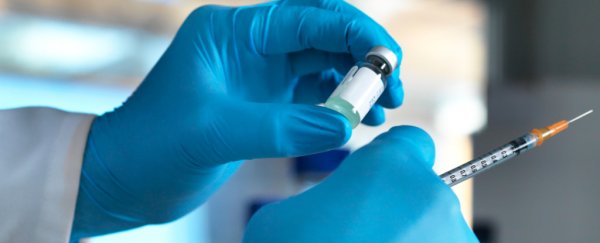There may be hope yet for a universal flu vaccine - one powerful dose of immunisation that can provide long-lasting protection for multiple influenza strains, all in a single shot.
A discovery like that would be a holy grail for public health, and after more than a decade of careful research, a specific version called FLU-v is now moving into the last rounds of clinical testing.
So far, researchers say the results have been "very encouraging", and the vaccine has successfully passed phase I and phase II clinical trials. Although trials in these phases are limited to assessing the safety of the vaccine, there's also evidence it might be effective.
In the latest round of randomised, double-blind, placebo-controlled trials, the jab was found to promote antibody responses and immune system changes among 175 healthy adult participants. While this doesn't mean the vaccine can defend against the flu virus itself, these are certainly powerful attributes.
"So far we have carried out four clinical trials with FLU-v," Olga Pleguezuelos, who works at the pharmaceutical development firm SEEK, told ScienceAlert, "and the take home message is that the vaccine induces cellular and antibody responses that can still be detected six months post-immunisation."
Such lasting resistance is invaluable given how quickly the influenza virus can change. The group of viruses collectively responsible for giving us 'the flu' are such shapeshifters, they easily slip out of our grasp each season.
Each flu season, researchers must predict upcoming strains and develop vaccines, but these are no good if the virus mutates mid-season or an unexpected strain suddenly shows up.
In the past, Pleguezuelos says, research has focussed on finding a 'super antibody'. Antibodies are what makes the current yearly flu vaccine work, by binding to the free virus and stopping it from infecting cells. A super antibody would be one that can somehow attach to all flu strains in the same way.
But that approach hasn't been altogether successful, so this time, researchers focused on the virus itself, trying to grasp the parts of it that remain the same, regardless of the strain.
Using a computer algorithm, the team identified which regions in the proteins of the influenza virus have not changed over time. They then latched on to these bits, while the virus took them 'for a ride'.
"FLU-v contains four different components against four different regions of the flu virus, so if one changed, three will still provide efficacy," explains Pleguezuelos.
The vaccine works by activating T-cells that detect a specific region of the flu virus, thereby triggering a chain of events in the immune system that stops and destroys the infection.
"It has taken many years for the scientific community to recognise that the T-cell approach is a valid one," Pleguezuelos told ScienceAlert.
"The pandemic in 2009-2010 showed that people that were exposed to the virus but were protected were those with pre-existing T-cell responses to regions of the virus."
After the novel strain of H1N1 influenza emerged in 2009, some research certainly suggested T-cells would be a good target.
Evidence from animal models shows that T-cells can provide multiple avenues of protection against the influenza virus, and some argue this overcomes the limitations of current vaccines, which rely on antibodies quite limited in their scope.
If FLU-v is found effective against the flu in humans, Amesh Adalja, an infectious-diseases specialist at Johns Hopkins University, said it could change the dynamics between humans and the influenza virus in a "very positive way."
The authors say the vaccine is ready to enter phase III clinical development to test safety and efficacy against the actual influenza virus and a much larger sample size. They're just waiting on funding.
"It's long been a joke that a universal flu vaccine is always five years away," Adalja told Live Science.
"But I think, this time, it really is coming within the next five years."
The study was published in the Annals of Internal Medicine.
